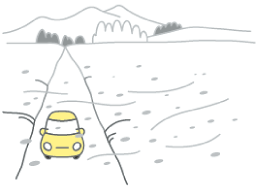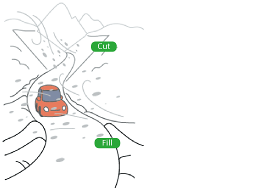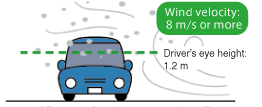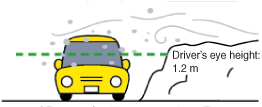|


Roads prone to poor visibility are located...
|

In flat, open fields.
Poor visibility and snowdrifts are likely to occur on roads in flat, open areas, where there are few trees and buildings to block airborne snow. On windy winter days, be particularly careful when driving through large cultivated fields and pastures, as these turn into large snow fields. |

At mountain passes and other steep areas.
Weather and visibility can change abruptly at mountain passes and other steep areas. Be careful when driving in such areas.
At cut sections and at transitions between cuts and fills.
At deep cut road sections, snowdrifts and poor visibility can result from snow being blow from the flat land above the cuts. Also, at transitions between cuts and embankments, poor visibility can result from snow blowing from the embankments to the cuts. |
Poor visibility is likely occur when...

The air temperature is low and it is windy.
When the air temperature is low and the wind is blowing at 8 m/s or more, snow particles blow up to eye height or higher. This is called blowing snow. When snow whirls to more than the eye height of a passenger car driver (1.2 m), the snow greatly hinders driving. It can cause severe reductions in visibility distance. |

There are high snow banks at the roadside.
When snow banks at the roadside are high, snow blown from them reaches the height of the driver’s eyes and causes poor visibility. When the roadside snow banks are high from heavy snowfall, be cautious about low visibility even when it isn’t that windy. |

Snow is blown up by heavy vehicles.
It’s likely that visibility will suddenly deteriorate when a heavy vehicle blows snow up from the road. When a heavy vehicle pulls ahead, the sudden whiteout can be startling. Also, when fresh snow covers the road, be cautious of snow blown up by cars coming toward you or passing you. |

Beware of whiteouts.
Without visual contrast, it’s difficult to distinguish an object from its background. On winter roads where the surroundings become all white, you may feel that the visibility distance is much worse than it really is, because it becomes harder to distinguish the road from the background. Sometimes a phenomenon called whiteout occurs. Under this condition, you can’t see anything except white snow, so be extremely careful. |
|






